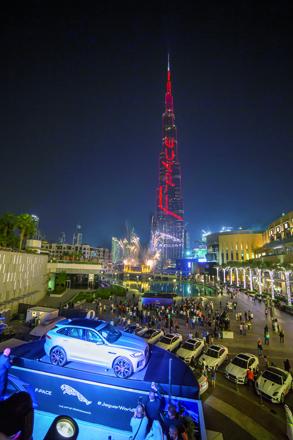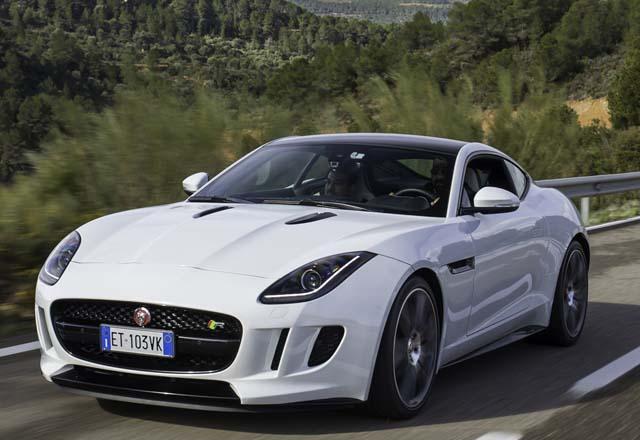You are here
Jaguar E-Pace P250 AWD R-Dynamic: Small, stylish and sporty SUV
By Ghaith Madadha - Apr 01,2019 - Last updated at Apr 01,2019

Photo courtesy of Jaguar
Jaguar’s second foray into the lucrative and ever burgeoning premium SUV segment, the E-pace is a compact and sporty junior stablemate for the larger F-Pace, and is a more attainable brand entry point.
Intended to capture and reinterpret Jaguar’s sporting and upmarket automotive ethos into a trendy, practical and high riding SUV format for young families, the E-Pace — like the F-Pace before it — takes inspiration from the Jaguar F-Type sports car, which is held up as the car that most distils the British automaker’s brand identity.
Feisty looks
Sharing a similar profile and rear quarter design elements as the larger F-Pace SUV, and similarly slim, moody high-set rear lights, clearly inspired by the F-Type sports car, the E-Pace features similarly muscular rear haunches and descending roofline. But with its shorter, narrower dimensions and clearly shorter rear overhang resembles a more upright or compressed interpretation of its larger SUV sister.
The F-Pace’s slim and heavily browed headlights owe more to Jaguar’s charismatic saloon car range, the E-Pace’s front treatment take more closely reflects that of the F-Type.
With similarly sweptback headlights and wide and snouty mesh grille as its sports car sibling, the E-Pace has a less dramatic demeanour than either F-Type or F-Pace. But with huge tailgate spoiler, optional 20-inch alloy wheels, dual integrated tailpipes and sportier R-Dynamic package with gloss black and satin chrome highlights and body coloured wheel-arch surrounds, the E-Pace’s character is more playfully feisty than outwardly aggressive.
With R-Dynamic specification, as driven, the E-pace also gains sportier body-hugging contrast stitched front seats, stainless steel treadplates and pedals, and sportier steering-mounted gearbox paddle-shifters.
Punchy performer
Break other current Jaguars’ in-line engine rear-drive based line-up, the E-Pace is the brand’s first transverse engine platform vehicle since the Ford Mondeo-based X-Type saloon and estate circa 2001-2009. With front-wheel-drive only offered for the most junior D150 version, all other E-Pace variants however feature standard all-wheel-drive for more confident road-holding and to better put down power to the road.
Similarly, all but the entry level diesels receive a standard slick-shifting 9-speed automatic gearbox with a broad range of closely spaced ratios to maximise performance, versatility, refinement and efficiency.
Powered exclusively by five petrol and diesel variants of Jaguar land Rover’s recent inhouse developed turbocharged 2-litre 4-cylinder engine, the second to range topping petrol P250 AWD version driven develops a punchy 245BHP at 5,500rpm and thick 269lb/ft wedge of torque throughout a broad and accessible 1,200-4,500 rpm mid-range.
A somewhat low revving engine with faint turbo lag from idling, the E-Pace P250, however, feels muscularly abundant, ever responsive and eager when spooled, with brisk 7.1-second 0-100km/h acceleration and 230km/h top speed contrasting with restrained 8.3/100km combined fuel consumption.
Agile and alert
Further departing from other current Jaguars, the E-Pace eschews aluminium construction in favour of more traditional steel, to reduce costs for customers. Though also easier to repair in the long run, the steel-built E-Pace weighs in at a not insignificant 1,832kg for a 4.4-metre long vehicle. Nevertheless, the E-Pace P250 drives with a zesty and flexibly urgent manner, especially when one chooses its aggressive Dynamic drive mode, where throttle, gearbox shifts and steering responses are sharpened up. Other modes include Normal, Eco, Rain, Ice and Snow and individually tailored modes.
Driven on largely smooth and straight UAE roads rather than twistier European or Jordanian roads the P250 drove with a good ride and handling compromise. With its well set-up MacPherson strut front and integral multi-link rear suspension providing good body control given its weight and relatively high centre of gravity, the E-pace also seemed to well absorb road imperfections despite its low profile 245/45R20 tyres.
Narrower tyre options with higher sidewalls would add more comfort, reduce unsprung weight and perhaps improved road feel from its quick, direct and well-weighted steering.
Compact comfort
Stable, settled and reassuring at speed, the E-Pace feels alert and ready to pounce into corners encountered during test drive with a tidy, almost hatchback-like agility for its segment. Eager into corner like a front-driver, the compact E-Pace nevertheless digs into corners to bolt out sure-footedly as its four-wheel-drive system allocates power between front and rear as necessary.
Fitted with numerous driver assistance features including blindspot and lane-keeping warnings, one did, however, find it a more fluent drive with lane-keeping assistance disabled to avoid unwanted steering resistance when manoeuvring briskly.
Refined and well insulated inside, the E-Pace’s cabin features user-friendly and uncomplicated layouts with sleek contemporary design. Supportive, well-spaced and comfortable in front, the E-Pace’s well-adjustable and commanding driving position provides good front and near side visibility, but a thick rakishly slanted A-pillar slightly restricts front-side passenger side visibility.
Equipped with numerous infotainment, safety and convenience features, including a 4G wifi hotspot, the E-Pace’s reversing camera proved particularly useful. Designed for younger families, the E-Pace’s rear seats and access is perfectly suited for children but can tight fitting for large, tall adults. Meanwhile generous 577-litre boot volume expands to 1,234-litres.
TECHNICAL SPECIFICATIONS
Engine: 2-litre, turbocharged, transverse 4-cylinders
Bore x stroke: 83 x 92.3mm
Compression ratio: 10.5:1 (+/-0.5:1)
Valve-train: 16-valve, DOHC, continuously variable valve timing, direct injection
Gearbox: 9-speed automatic, four-wheel-drive
Ratios: 1st 4.713; 2nd 2.842; 3rd 1.909; 4th 1.382; 5th 1.0; 6th 0.808; 7th 0.699; 8th 0.58; 9th 0.48
Reverse/final drive: 3.83/4.544
Power, BHP (PS) [kW]: 245 (249) [183] @5,500rpm
Specific power: 122.6BHP/litre
Power -to-weight ratio: 133.7BHP/tonne
Torque, lb/ft (Nm): 269 (365) @1,200-4,500rpm
Specific torque: 182.6Nm/litre
Torque-to-weight ratio: 199.2Nm/tonne
0-100km/h: 7.1-seconds
Top speed: 230km/h
Fuel economy, combined: 8.3-litres/100km
CO2 emissions, combined: 189g/km
Fuel capacity: 68.5-litres
Length: 4,395mm
Width: 1,984mm
Height: 1,649mm
Wheelbase: 2,681mm
Overhang, F/R: 882/832mm
Track, F/R: 1,625/1,624mm
Ground clearance: 204mm
Approach/break-over/departure angles: 22.8°/21.1°/29.4°
Ascent/descent gradient: 45°
Side slope gradient: 35°
Aerodynamic drag co-efficiency: 0.33
Boot capacity, min/max: 577-/1,234-litres
Kerb weight: 1,832kg
Suspension, F/R: Double wishbones/ integral multi-link
Steering: Electric-assisted rack & pinion
Turning circle: 11.46-metres
Lock-to-lock: 2.31-turns
Brakes, F/R: Ventilated discs, 349mm/discs, 300mm
Tyres: 245/45R20 (optional)
Related Articles
Launched regionally in spectacular fashion in Dubai last week, the Jaguar F-Pace stands to become a transformative product for the British s
Sportier and arguably even better looking than its convertible sister launched last year, this year’s Jaguar F-Type Coupe is a classy, quick and beguilingly beautiful two-seat sports car that consolidates the resurgent British brand’s sporting credentials.
Jaguar’s best effort to decisively break into the once lucrative and high-selling German-dominated compact premium saloon market, the XE is



















